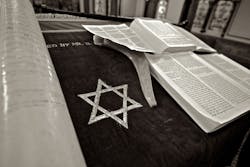Study of Orthodox Jews may help guide COVID-19 prevention in culturally bonded groups
Following Purim in March 2020, close-knit Orthodox Jewish communities across the nation were hit by outbreaks of COVID-19 because the holiday involves much social interaction, including festive meals, religious gatherings and gift-giving — and in 2020, Purim occurred before practices such as masking and physical distancing were commonplace, according to a news release from Johns Hopkins Medicine.
Data from a Johns Hopkins Medicine epidemiological study of those outbreaks are being used to guide prevention practices that enable safe fulfilling of cultural and religious needs.
Researchers created the Multi-Institutional sTudy analyZing anti-coV-2 Antibodies Cohort, or MITZVA Cohort (the acronym is taken from the Hebrew word for “commandment” and often refers to a “good deed”), to explore the epidemiology of the Purim 2020 COVID-19 spread within the large Orthodox Jewish communities of Brooklyn, New York; Lakewood, New Jersey; Los Angeles, California; Nassau and Sullivan counties, New York; New Haven, Connecticut; and Detroit, Michigan. Also included were Orthodox Jews who resided in Colorado, Florida, Maryland, North Carolina, Ohio, Pennsylvania, and Washington State.
Study participants were first asked to complete a survey to define their demographic characteristics; whether they had any symptoms of SARS-CoV-2 infection before, during or shortly after the 2020 Purim holiday; the onset of any symptoms experienced; and if they had already tested positive for the virus.
Out of 12,626 people given the questionnaire, 9,507 completed it and were invited to undergo SARS-CoV-2 antibody testing in the second stage of the study. Of those participants, 6,665 (70.1%) were screened for immunoglobin G (IgG) antibodies to the nucleocapsid (outer covering) protein of SARS-CoV-2 between May 14 and 30, 2020.
The survey results defined the date range for possible COVID-19 symptom onset as from Dec. 1, 2019, to May 26, 2020. More than three-quarters, 77%, of the respondents reported their first symptoms between March 9 and April 1, with another 15% stating theirs began after April 1 — indicating that they were likely exposed just before or during the Purim season.
Among the study participants who tested positive for SARS-CoV-2 IgG antibodies, the researchers say that most (between 82% and 94% in the primary five communities examined) reported the onset of COVID-19 symptoms between March 9 and March 31, 2020.
The seroprevalence rates — the percentage of people in a population with antibodies against, and indicating infection with, SARS-CoV-2 — were consistently higher in the Orthodox Jewish communities than those in neighboring areas during the study time period.
Once COVID-19 prevention measures were established and promoted by public health authorities, local and national Orthodox Jewish leaders put forth mandates for their communities to comply and developed culturally sensitive policies to address how to safely engage in prayer services, family and communal gatherings and social support systems.

